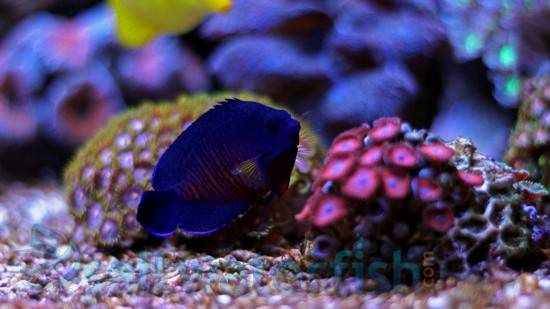Pink Belly Wrasse
Halichoeres margaritaceus/nebulosus
(0 Reviews)

Pink Belly Wrasse
Halichoeres margaritaceus/nebulosus
(0 Reviews)
{{ item.name }}
Size: {{ item.extra_field_3 }}
${{ getFormattedPrice(item.saleprice) }} ${{ getFormattedPrice(item.price) }}
To join the waiting list, click here
Free Shipping
With
$199.00
or more in Marine Life.
More details...
Pink Belly Wrasse Care Facts
| Size: | 6 inches |
|---|---|
| Care Level: | Moderate |
| Temperament: | Peaceful |
| Reef Safe: | Yes |
| Origin: | Indo-Pacific |
| Acclimation Time: | 3+ hours |
| Coral Safe: | With Caution |
| Invertebrate Safe: | No |
| Minimum Tank Size: | 50 Gallons |
The Pink Belly Wrasse is commonly referred as the Pearl-spotted Wrasse. It has beautiful coloration with the top half of the body being a light bush pink color and the bottom half a pearly white color with a bright pink splotch on their chest that can make a stunning addition to any home aquarium. The Pink Belly Wrasse can reach up to a maximum size of 6 inches and should be kept in a tank of not less than 50 gallons. The tank should be furnished well with a sand bed of at least 3 inches, and a assortment of live rocks and corals. This Wrasse can fed on variety of food including finely chopped shrimp, mysis, fortified brine shrimp, finely chopped fish, black worms and other meaty frozen foods. They makes a good addition to fish-only tanks as they may harass inverts and corals in reef tanks.
Pink Belly Wrasse Care Guide
The Pink Belly Wrasse (Halichoeres margaritaceus/nebulosus), or the Pink Pearl Wrasse or Pink Margin Wrasse, is a captivating marine fish species highly sought by saltwater aquarium enthusiasts. Below is an educational and formal product description covering various aspects of keeping this species in a saltwater aquarium environment.
Pink Belly Wrasse Habitat
Pink Belly Wrasses are native to the tropical waters of the Indo-Pacific region, specifically the Red Sea, Maldives, and Indonesia. They inhabit coral reefs, rocky shores, and lagoons, often darting in and out of crevices for food.
Reef Compatibility
This species is considered reef-safe, making them suitable for reef aquarium setups. However, caution should be exercised with small ornamental crustaceans and smaller fish species, as Pink Belly Wrasses may exhibit predatory behavior toward them.
Pink Belly Wrasse Size and Lifespan
Pink Belly Wrasses typically reach a maximum size of around 6 inches in captivity. They can live for up to 5 to 7 years with proper care, providing long-term enjoyment for aquarium enthusiasts.
Pink Belly Wrasse Diet in Captivity
In the wild, Pink Belly Wrasses primarily feed on small invertebrates, zooplankton, and algae. In captivity, they should be offered a varied diet of high-quality marine flakes, pellets, and frozen foods such as mysis shrimp, brine shrimp, and chopped seafood. Supplementing their diet with live foods occasionally can also help mimic their natural feeding behaviors.
Pink Belly Wrasse Aquacultured Availability
While Pink Belly Wrasses are not as commonly aquacultured as other marine fish species, they are occasionally available to hobbyists through select suppliers. When purchasing, it's advisable to inquire about the source of the fish to support sustainable aquaculture practices.
Pink Belly Wrasse Compatibility with Other Fish and Invertebrates
Pink Belly Wrasses generally exhibit peaceful behavior toward other tank mates, making them suitable for community aquariums. Compatible tank mates include peaceful to moderately aggressive species such as:
- Blue Tang (Paracanthurus hepatus)
- Firefish Goby (Nemateleotris magnifica)
- Naso Tang (Naso lituratus)
- Banggai Cardinalfish (Pterapogon kauderni)
- Orchid Dottyback (Pseudochromis fridmani)
Pink Belly Wrasse Sexual Dimorphism
Male Pink Belly Wrasses typically exhibit more vibrant coloration than females, with males often displaying a deeper pink coloration on their bellies and dorsal fins. Additionally, males may develop elongated dorsal fins as they mature.
Pink Belly Wrasse Juvenile to Adult Coloration Changes
Juvenile Pink Belly Wrasses often display more muted colors than adults. As they mature, their colors intensify, with adult males exhibiting vibrant pink and yellow hues, while females tend to have more subdued coloration.
Pink Belly Wrasse Temperament
Pink Belly Wrasses are known for their active and curious behavior. They constantly explore their surroundings within the aquarium. They are generally peaceful toward other tank mates but may exhibit territorial behavior toward conspecifics or similar species.
Pink Belly Wrasse Tank Requirements
Pink Belly Wrasses thrive in well-established saltwater aquariums with plenty of live rock for hiding and exploring. A minimum tank size of 50 gallons is recommended to provide ample swimming space and to accommodate their active nature.
Pink Belly Wrasse Water Conditions
Maintaining stable water parameters is crucial for the health and well-being of Pink Belly Wrasses. Recommended water conditions include:
• pH: 8.1 to 8.4
• Salinity: 1.023 to 1.025 specific gravity
• Water Temperature: 75°F to 82°F (24°C to 28°C)
• Water Flow: Moderate to high flow to simulate their natural habitat conditions.
Other Common Names of Pink Belly Wrasse
Other Common Names are Pink Pearl Wrasse and Pink Margin Wrasse.
Why Choose the Pink Belly Wrasse from Saltwaterfish.com
When purchasing the Pink Belly Wrasse from Saltwaterfish.com, customers can expect to receive healthy, quality specimens from reputable suppliers. With a commitment to sustainable aquaculture practices and a wide selection of marine fish and invertebrates, Saltwaterfish.com allows enthusiasts to create thriving marine aquarium ecosystems while supporting responsible stewardship of marine resources.
In conclusion, the Pink Belly Wrasse is a captivating marine fish species suitable for saltwater aquarium enthusiasts seeking an active and colorful addition to their tank.
Currently Pink Belly Wrasse does not have any reviews.















